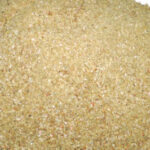Ah, the Easter cactus! Springtime blooms abound from this succulent. Named because of the time of year it flowers, it’s a popular plant for indoor gardeners. You may have heard of similar plants – namely the Christmas cactus and Thanksgiving cactus. They, too, bloom around the holiday designated by their common name.
Even when it’s not flowering, the Easter cactus is a stunner. Long, narrow “arms” branch off of the plant’s base. Fleshy leaf pads replace leaves on this plant, and it’s from those pads that the flowers will bloom.
Everyone’s heard of these holiday cacti, but today we’ll talk about how best to care for them. You can develop a succulent collection that will have something in flower year-round!
Overview
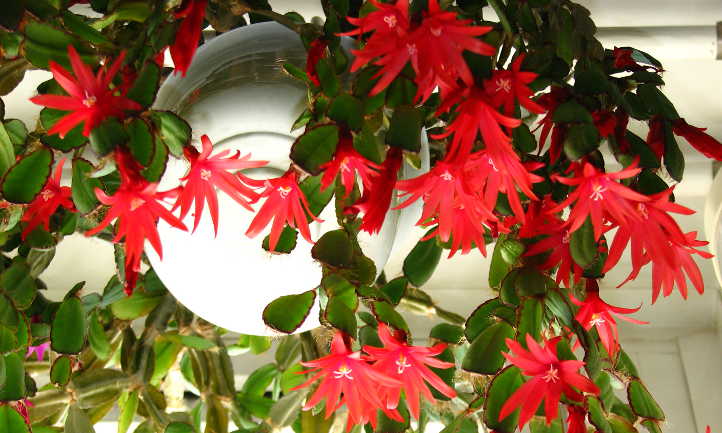
| Scientific Name: | Hatiora gaertneri |
| Common Name(s): | Easter cactus, Whitsun cactus |
| Family: | Cactaceae |
| Height: | Max height is 25″, but can be kept shorter |
| Sun: | Bright, indirect light. Avoid direct sun. |
| Soil: | Soilless cactus potting mix preferred. |
| Water: | Limited watering per recommendations, lots of humidity |
| Pests & Diseases: | Some pests, one bacterial disease and a few fungal diseases. |
All About The Easter Cactus
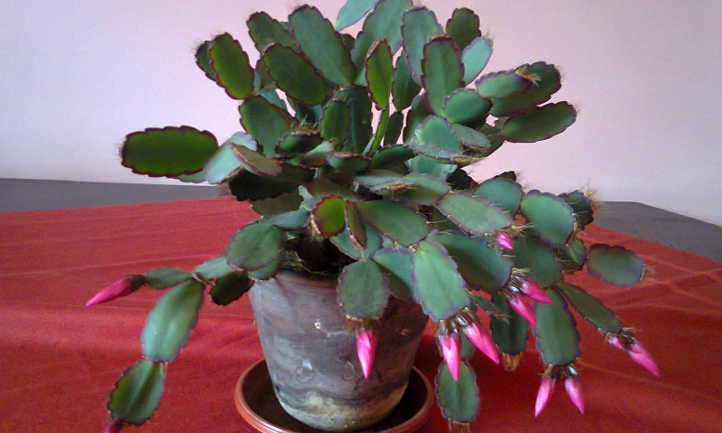
Don’t confuse this one with the Christmas cactus or the Thanksgiving cactus. The Easter cactus is a different species. However, Easter, Christmas, and Thanksgiving cactus are all members of the same genus: Schlumbergera.
There is some confusion about this as the Easter cactus was once known as Hatiora gaertneri but is now classed as Schlumbergera gaertneri. It’s sometimes called the Whitsun cactus.
Not only can you tell an Easter cactus apart from Thanksgiving cactus and Christmas cactus by the time they bloom, but there are also morphological differences between these holiday cacti as well. The leaf edges of the Thanksgiving cactus are sharply pointed, and those of the Christmas cactus are tear-shaped. Easter cacti have a very rounded leaf edge.
The natural flower coloration of the Easter cactus is red. Thanks to crossbreeding with Hatiora rosea, there are pink and white flowering hybrids. But this spring cactus usually produces vivid scarlet blooms!
Less spines are evident on this cacti, and gardeners are thankful for that! Their natural environment is quite different from those other cacti as well. It originates in Brazilian sub-tropical rain forests. There, it lives as an epiphyte in trees and on rocky outcroppings.
At times, Schlumbergera gaertneri can be a bit finicky. It’s a little more tricky to care for than your Christmas cactus or Thanksgiving cacti. But if properly maintained, your plant may bloom not just at Easter but a second time in the summer months.
Care For Easter Cactus
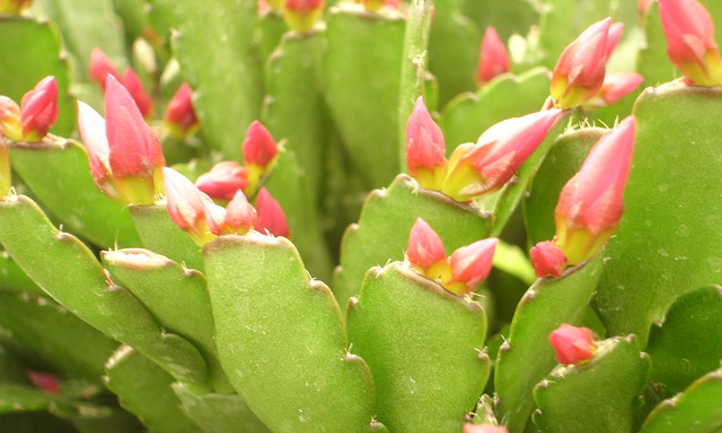
Let’s discuss the finer points of growing the Easter cactus plant. While it’s certainly not impossible to do, this spring cactus does prefer some specific conditions!
Light & Temperature
Bright but indirect sunlight is ideal for your Easter cactus. Remember, these are epiphytes that normally grow on tree branches. Partial shade environments are perfect. As long as there’s an abundance of natural light for 10-12 hours per day, they’ll continue to thrive.
Avoid direct sunlight, especially during the hottest part of the day. Direct sun can cause sunburn on the delicate spring cactus pads.
The Easter cactus also tends to be a bit picky about the weather. Unlike a desert cactus, it prefers cooler temperatures. Nighttime lows should reach 55-60 degrees. Daytime temps can get into the 80’s, but this plant prefers the 70-degree range. Needless to say, it’s easiest to maintain the right range indoors!
In the winter months, you’ll want to give these plants at least 12-14 hours of darkness per day. This encourages them to rest up before bursting into spring flower. This darkness period is essential for Christmas and Thanksgiving cacti too.
Water & Humidity

As a subtropical rainforest-growing species, much of the Easter cactus water comes from rainfall. Its normal rainy season is from spring through late summer. That’s when watering is key.
But there’s a trick to this. Wait to resume regular watering until the Easter cactus flower buds have set and are starting to bloom. Slightly drier conditions occur through the fall and winter months. That’s when the plant is gathering its energy for its floral show.
While the Easter cactus does need some water during the fall and winter months, it should be just enough to sustain the plant. As the flowers start to appear, gradually increase the watering frequency. Mimic a tropical deluge by providing lots of water, all at once. Let it drain off well, and don’t leave it in standing water. Wait until the soil dries out a bit before you give it another watering.
Humidity is also important for this spring cactus. It likes a 50-60% humidity range at all times. Placing a pebble tray underneath the plant with a little water can provide the right range. A humidifier works well too.
The Easter cactus will move into its active growing phase once flowering subsides. At that point, more frequent watering is necessary to fuel its growth until the heat of summer begins to ebb. Then, once again, reduce the watering frequency. Allow the soil to dry out between waterings in late fall and winter.
Soil
Whatever you do, don’t use that bag of all-purpose potting soil from the big box store for your Easter cactus. It won’t like it at all.
Provide a good cactus or succulent mix for this plant. If you can’t find a cactus mix, you can opt for one intended for orchids. It should be extremely well-draining and shouldn’t get muddy. Soilless mixes are great for this spring cactus, as they aren’t desert cacti their natural environment doesn’t have soil.
I like to blend my own using a mix of 60% peat moss and 40% perlite. Peat moss is slightly acidic and retains just enough water to keep the plant going. The perlite ensures it drains off well.
That slight acidity is preferred by your holiday cactus as well. Most grow well in the 5.0-6.0 range. Some pre-made potting mixes add a little pH buffer to them, but they’re still just acidic enough to allow your plant to thrive.
Fertilizer for Easter Cacti

Fertilization for the Easter cactus plant is tricky as well. The period in which fertilization is most important is during active plant growth. Wait until after it’s finished flowering.
I recommend using a liquid fertilizer. Start with a 10-10-5 formulation and dilute it to at least half-strength. Quarter strength is even better to avoid over-fertilizing. Fertilize at the base of your spring cactus every two weeks through the active growth season.
As the fall approaches, reduce fertilizing frequency. Your Easter cactus will be going into its winter rest period and won’t need regular fertilizer at that point.
Avoid applying the fertilizer directly to the spring cactus pads. Instead, keep it down in the growing medium where it belongs. The plant will use its fine root structure to consume it from there.
Easter Cactus Propagation
Most Easter cacti do extremely well as cuttings, and the same can be said for Thanksgiving and Christmas cacti. In fact, it’s the preferred method to propagate your holiday cactus!
Examine your Easter cactus in the late spring or early summer. Select a leaf tip that seems full and fleshy, one that doesn’t show signs of sunburn damage. Use a sterilized sharp knife or sterile pruning shears to remove the cutting. Make your cut at the joint where the leaf tip curves inward to its stalk.
Allow the cut edge to dry out for a couple of days, like you would desert cacti. This gives it enough time to callus over. You can then tuck it into moistened planting medium. The potting blend I use (60% peat moss, 40% perlite) is ideal for this. Keep the medium moist but not soggy.
Placing a plastic bag over the top of your pot can help provide additional humidity. You can also set it into a terrarium if you’d like. It will develop fine roots over time.
Pruning Easter Cacti
Pruning is more a case of personal preference than a necessity when it comes to care for Easter cactus. If you do opt to prune, be sure to do so after flowering. Otherwise, you may be removing the flower buds.
Often, pruning is paired with annual repotting. Wait until Easter cactus blooms have subsided in the late spring. Then, carefully lift your plant from its pot. Clean the pot well with warm soapy water. Dust off the old medium from the plant’s roots and repot in fresh potting medium.
At that point, examine your plant to decide if you wish to prune. If so, break off the uppermost leaf pad from the stem, being sure to break at the joint. You can opt for clean and sterilized pruning shears if you prefer. Trim off any uneven breaks.
Annual pruning of this sort will encourage bushier growth habits. Be sure to do it right after the flowering has subsided, but while it’s still actively growing. Do not prune in the fall or winter.
Forcing The Easter Cactus to Bloom
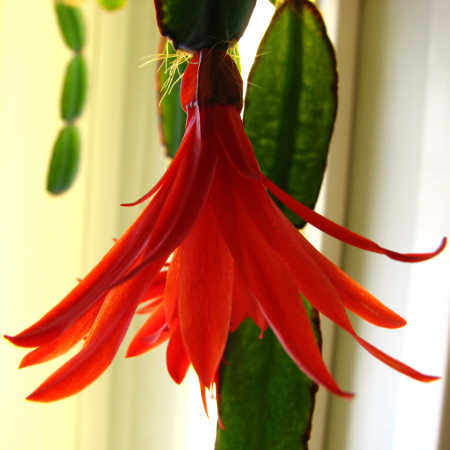
Many people find it hard to coax flowers out of their cactus in its early spring blooming period, but it can be done. It’s actually caused by a little neglect!
First, stop fertilizing your plant. This occurs in the fall anyway, so it’s no different than your normal process.
Once your plant isn’t being fertilized, move it to where it receives 12-14 hours of darkness per day. This causes the plant to assume the days have gotten shorter.
In early spring, reduce the temperature around your plant. It’ll require 8-12 weeks of cooler temperatures for bud set. Avoid placing it in drafty areas or near heaters, and keep it out of direct sunlight.
Reduce the frequency of watering. You should be sparing with the water during this simulated cool period and the winter months.
Once 8-12 weeks have passed, increase the temperature around your plant to 60-65 degrees. It will gradually start to come out of its dormant state and should start blooming in Feb/March.
Troubleshooting Easter Cacti
We all try to care for our plants to the best of our abilities. But even the most experienced gardener may encounter a few difficulties. Let’s discuss some of the growing problems you might encounter.
Growing Problems
Your cactus should be a bright green color. If it is turning greyish-green or bluish, or any part is shriveling, it’s usually a sign of too much water. There are two potential ways to fix this. Make sure your potting medium isn’t holding too much water. Also, reduce frequency of watering the plant.
If you find your flower buds are falling off as if they were cut, it’s too hot for your plant. Continued warm temperatures above 90 degrees Fahrenheit will cause more buds to drop. Try to keep your plant at or below 80 degrees.
Your plant should form flower buds in the fall to winter. If buds aren’t forming, there’s two possible reasons. Either it’s not dark enough at night, or it’s not bright enough during the day. Make sure all lights near your plant are off for 12-14 hours a day. Also, make sure there’s ample indirect light for your plant during the daytime.
Pests
Most of the time, pests show little to no interest in Easter cactus. This makes caring for Easter cactus plants a little easier. But there are a few which might appear.
Root knot nematodes can cause damage to the hairlike roots of your cacti. This results in portions of the plant turning reddish-brown in color. Growth may be stunted, and the plant can wilt.
Fungus gnat larvae also find the roots of your cacti to be tasty. These tend to cause similar problems to root-knot nematodes. Adult fungus gnats may be visible flying around the plant as well.
In both of these cases, adding beneficial nematodes to your soil will resolve the problem. These helpful nematodes will consume both fungus gnat larvae and pestilent nematodes.
Mealybugs and other scale insects tend to be a common cactus pest. With mealybugs, they’re easily identifiable by the cottony white masses they form. Scale looks like round to oval bumps on the cactus pads.
To keep these scale insects at bay, a weekly application of neem oil will help. To remove them, dip the tip of a cotton swab in rubbing alcohol and rub it on the insect. The scale will become dehydrated and fall off.
Diseases
One bacterial disease and a few fungal diseases may appear. These are all extremely difficult to handle, so prevention is important.
The bacterial disease is Erwinia soft rot. It starts with a black and slimy lesion at the plant’s base. Slowly it progresses up along the stems or cladophylls of the plant. Over time it causes wilting, collapse of the plant, and death.
Drechslera cadophyll rot creates black and sunken spotting on the fleshy leaf pads. Fuzzy spores will develop in the sunken wounds.
Fusarium oxysporium creates tan lesions along the outer edges of your cactus pads. Over time, orangish fungal spores will appear on those edges.
Finally, pythium root rot or phytophthora root rot are fungal root rots. These are usually caused by soil that’s too wet around the roots. Wet soil makes a perfect environment for these fungi to develop.
With Erwinia soft rot, Drechslera cadophyll rot, and fusarium cadophyll rot, it’s going to be fatal. Remove plants with these symptoms and destroy them to prevent further spread. Avoid splashing while watering. This prevents fungal spores or bacteria from spreading to other plants. Avoid reusing the potting soil for another holiday cactus.
The root rots are easily prevented. Make sure you’re using a cactus blend for your potting mix, and don’t overwater. Keep the roots free of nematodes and gnat larvae to avoid damage that could cause infection.
Frequently Asked Questions
Q. Are Easter cactus and Christmas cactus the same?
A. They’re similar in appearance. They’re similar in that they flower during a specific holiday time. But they’re not the same species!
Q. How often do I need to fertilize Easter cactus?
A. Fertilize only during the active growing season after flowering subsides. Stop fertilizing for the fall and winter. Read the section above for more detail on fertilizing this cactus.
Q. Can I repot my Easter cactus?
A. Of course, you can repot your cactus! It’s best to do that after the flowers have faded, and at most once per year. You shouldn’t need to go up in pot size, as it seldom becomes root-bound. Read the section above on pruning for more information on proper potting techniques.
Q: Does Easter cactus bloom every year?
A: Yes, and sometimes it will put out two sets of blooms in one year.
Q: Can an Easter cactus go outside?
A: It can, especially in temperate areas with indirect bright light. You’ll have to ensure enough darkness is present to help your cacti bloom in early spring through summer.
Q: Does Easter cactus like full sun?
A: Easter cactus like bright light that is indirect. Provide some shade in full sun areas, or place your cactus so it’s slightly offset from intense light sources. Especially in the blooming period, you’ll need to ensure your cactus gets 12 to 14 hours of darkness per day to help it produce blooms.
Q: How long do Easter cactus live?
A: Unlike other holiday cacti, the Easter cactus only lives for 10 years. Both the Christmas and Thanksgiving cactus live for around 100.
Q: Should I deadhead my Easter cactus?
A: You certainly don’t have to, but doing so can help this tropical cactus push out another round of blooms during its spring blooming period.








